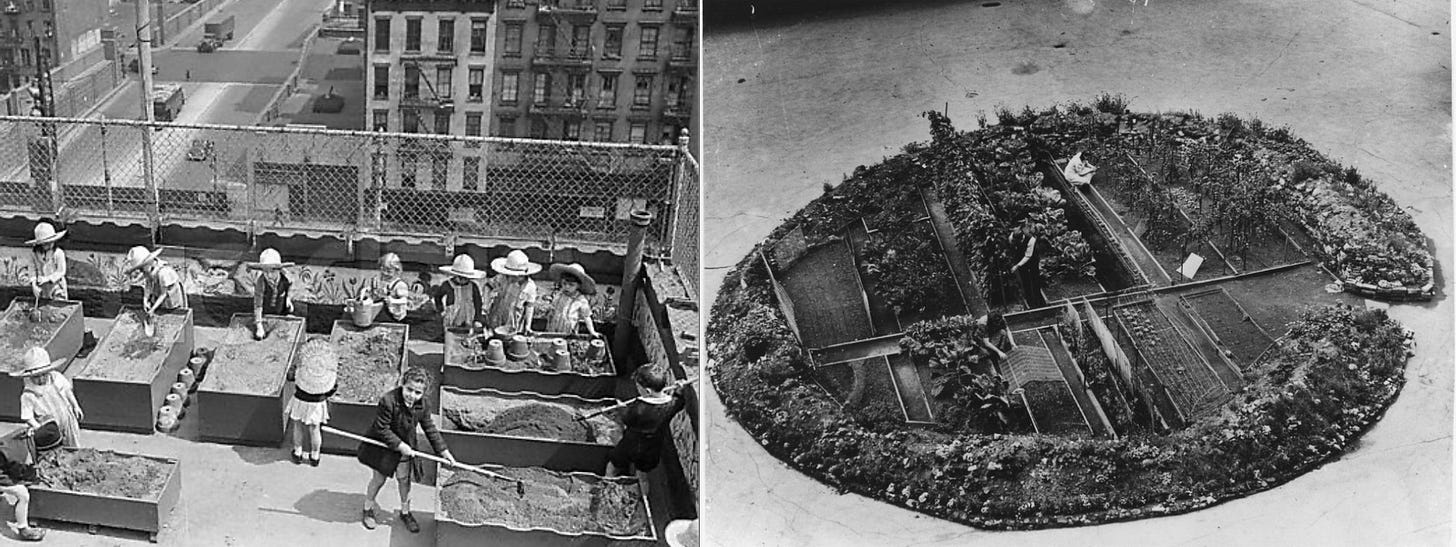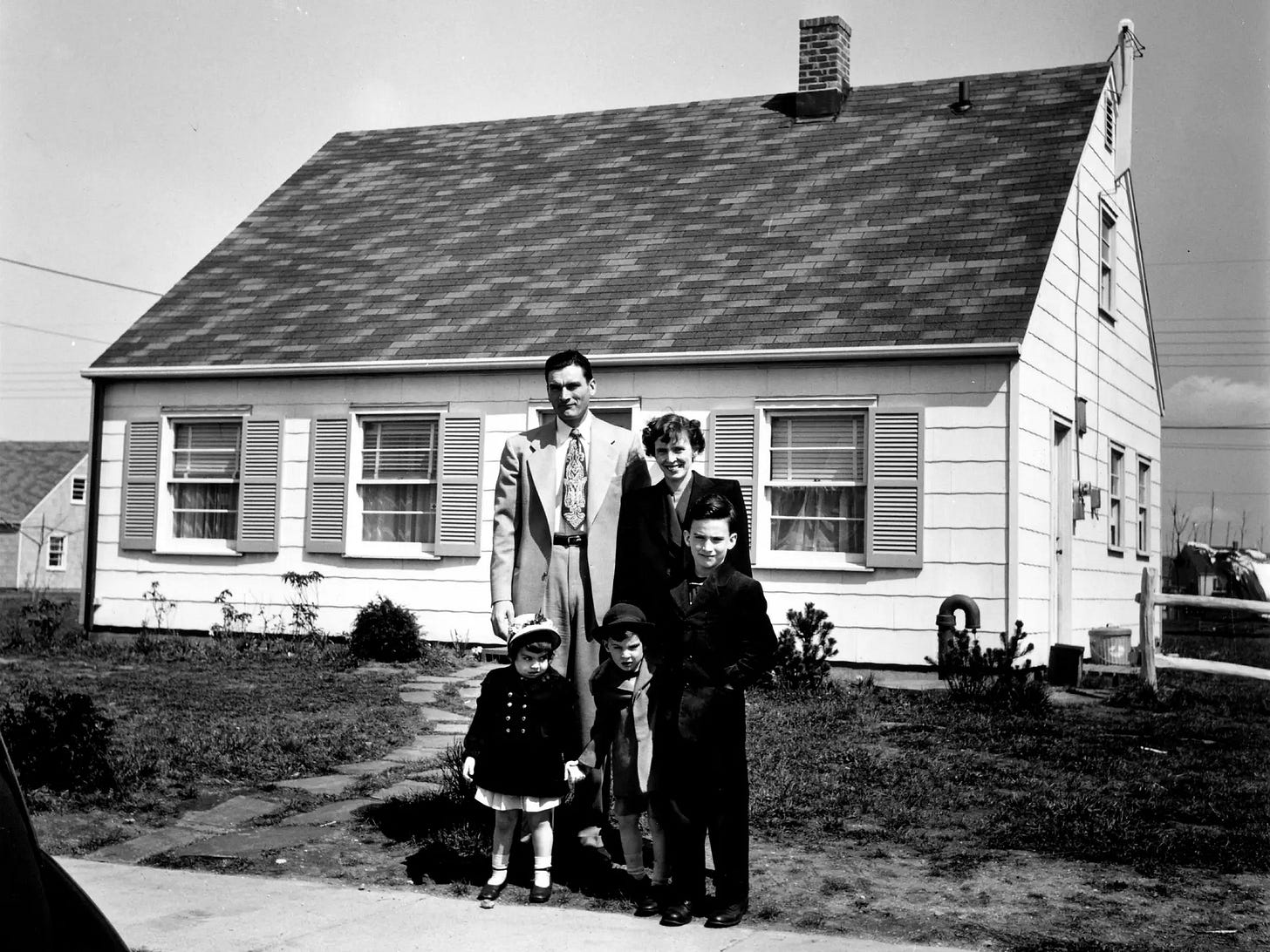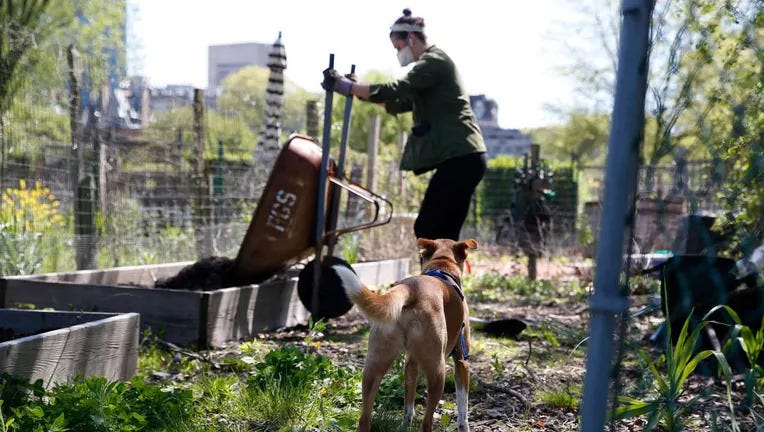Return of the Victory Garden
During World War I and World War II the government advocated that citizens grow some of their own food to alleviate pressure on commercial growers and their supply chains so their food could be sent to deployed soldiers. During WW I the gardens were part of national at-home efforts; they had more impact during WW II because of food rationing and because processed and canned foods were mostly shipped to the front lines. Non-combatants, mothers, children, the elderly, were given roles manifesting a direct impact on the on-going conflicts. Growing your own food was patriotic and a contribution to the war effort.
Unlike in Europe where food availability was a serious issue, there was little threat of US citizens going hungry. The victory garden movement was more about US societal solidarity than scarcity. The effort was driven by government and corporate promotional campaigns in libraries, community centers, and newsreels in movie theaters.
Nearly two-thirds of American households participated in some form of national harvest; even Eleanor Roosevelt planted a victory garden on the White House lawn. By 1943, close to 20 million families planted seven million acres of gardens across the United States, producing more than 15 billion pounds, or roughly 40 percent, of the fresh produce Americans consumed that year.
Steinhauer, Jennifer, “Victory Gardens Were More About Solidarity Than Survival,” The New York Times Magazine, July 15, 2020. https://www.nytimes.com/2020/07/15/magazine/victory-gardens-world-war-II.html
Open lots, rooftops, backyards were obvious candidates for victory gardens. Enterprising Americans used every available plot of land; for example, the green strip between the sidewalk and the roadway. They even used the centers of traffic circles to grow crops.
The National Victory Garden program was created by the War Food Administration in 1941. The top-down program not only advocated self-sufficiency, but also sought to alter American eating habits. Americans were urged to eat substitutes for meat, for example, soybeans, peanut butter, and eggs, so meat could be provided to servicemen. Americans were also urged to build and maintain chicken coops.
The end of WWII and the return home of the warfighters heralded manifest changes in American culture. The Servicemen's Readjustment Act of 1944, commonly known as the G.I. Bill, provided a range of benefits for some of the returning World War II veterans, including guaranteed home loans. With the post war Baby Boom and low home prices, families moved to the suburbs in the 1950s. Levittown, on Long Island, New York, is commonly recognized as the first modern suburb. It had swimming pools, shopping centers, and house lots with backyards, but no garden plots.
World War II marked a turning point in American manufacturers’ ability to manipulate food into forms never seen in nature. Out of the war came the technological processes to produce dried soup powders and pudding mixes, salad oils, canned fruit juices, and ready-to-eat meals. The organic and fresh Victory Garden kitchen of the war years was replaced by pre-packaged processed foods. Perhaps the ultimate icon of the shift was Jello-O. Culinary convenience was the watchword; entrusting corporations with food preparation was perhaps the ultimate postwar cultural shift. Ever watch the “Mad Men” television series? American tastes shifted away from fresh flavors and seasonal produce.
The counterculture “hippie” cuisine of the 1960s was a rejection of all of cultural forces that created Wonder Bread and TV dinners as well as an embrace of moving back towards nature, new ingredients and new flavors. Counterculture food had to be grown differently, sourced differently, cooked differently; it had to move back to its pre-industrial agriculture roots.
Americans, and many other cultures, have long turned to the soil in moments of upheaval to manage anxieties and imagine alternatives. Motives have varied across time as people respond to different circumstances. “There are certain very stabilizing forces in gardening that can ground us when we are feeling shaky, uncertain and terrified. It’s these predictable outcomes and predictable rhythms of the garden that are very comforting right now,” said Professor Joel Flagler of Rutgers University. https://www.agweek.com/lifestyle/the-pandemic-propelled-gardening-to-new-heights-will-the-trend-last
Today it is coronavirus that has set off a global home gardening boom. “More than 20 million novice gardeners picked up a trowel for the first time swelling the ranks of American gardeners to more than 63 million,” according to Bonnie Plants CEO Mike Sutterer. http://bonnie.multimedia-newsroom.com/index.php/2021/05/04/while-more-americans-are-growing-their-own-veggies-survey-finds-very-few-know-how-to-donate-their-extra-harvest/
Gardening made history in the spring of 2021, evidenced by Burpee Seed Co. selling more seed in March than any time in their 144-year history. Johnny’s Selected Seed noted a 270% increase in normal spring sales. Stokes Seed Co. sold four times its normal quantity of gardening products. Compared to spring 2019, 36 percent more Americans are growing vegetables, herbs and tomatoes this year, with 65 percent of those individuals saying their decision was tied to coronavirus in some way, according to new data from Scotts Miracle-Gro. https://www.eatingwell.com/article/7805501/were-experiencing-a-garden-boom-because-of-the-coronavirus/
You can garden anywhere with the right containers, soil, watering schedule, and sun exposure; your back yard, the balcony of your apartment, even a shelf inside, to include both vegetables and herbs. Tomatoes are a fruit, but you can grow them too; flowers too. You can experiment with location and the types of plants best suited for your “garden.” The litany of actionable gardening methods is legion … container gardening, vertical gardening, hanging gardens, window box gardening, square foot gardens, raised beds, no-till gardening, a lasagna garden (no, not the Italian dinner dish), straw bale gardening, keyhole gardening, permaculture gardening, potager gardening, aquaponic gardening, hydroponic gardening, hügelkultur (a German self-composting method), to name but a bunch (pun intended). You can look up these.
There are several excellent beginner books on how to garden in small spaces. Take a look at Rodale's Basic Organic Gardening: A Beginner's Guide to Starting a Healthy Garden by Deborah L. Martin, the All New Square Foot Gardening, 3rd Edition by Mel Bartholomew
Some people aver that organic gardening in a small space is too hard, and it undoubtedly takes more time and effort than a quick shot of commercial fertilizer. But do you really want to infect your plants synthetic fertilizers and pesticides?
What kind of seeds are best? Some assert that modern hybrids designed for planting in pots are the best and easiest to grow, but they are GMO seeds. Again, what are your objectives? Are you starting your own garden just to have food, or do you want the healthiest and most nutritious foods for your efforts?
“Heirloom seeds are passed down from generation to generation using open pollination. This means that the changes that have occurred in the development of heirloom plants are characteristics that have happened naturally over the course of time. To be considered an heirloom variety, the species of plant must be at least 40 years in the making. Over years and years of cultivation, heirloom plant varieties develop resistance to certain diseases and pests and learn to thrive in particular climates. … Heirloom seeds can be saved and planted year after year. They are never hybrids or GMO’s.”
https://www.gardeningchannel.com/heirloom-vs-organic-seeds-explained/
Seed Savers is a seed bank that houses a collection of more than twenty thousand rare, open-pollinated varieties. It is one of the best sources of heirloom and organic non-GMO seeds. https://www.seedsavers.org Another good source is Baker Creek Heirloom Seeds. https://www.rareseeds.com There are other heirloom seed suppliers.
One of the objectives of the Victory Garden program was to change people’s eating habits. The pandemic fostered a renewed focus on what and how we eat; it has brought us full circle, back to growing our own non-GMO heirloom food and victory over industrial agriculture. Happy gardening.
Fall has come, most farmers markets are gone for the year, and the ski season approaches … now is the time to plan your next spring garden. As you pull out your skis to have them prepped for the first snow, gather your garden materials into one place, decide what you are going to plant, order your seeds … have a plan. After that last memory-making run you will be set for new different memories, watching life spring. The benefits to your health (and your pocketbook) are worth the effort. And, perhaps, just maybe, if we all plant a garden, no matter how small, we can again foster social cohesion … ???










